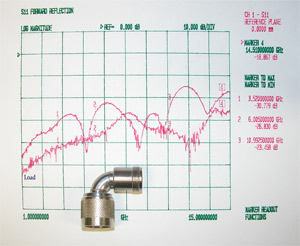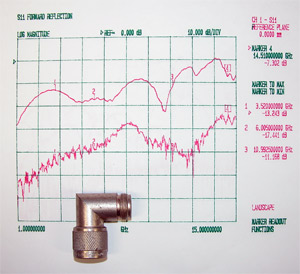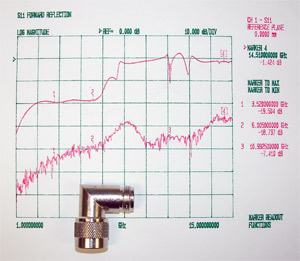Technical papers:
90° N-Connector Performance
The Ubiquitous Right Angle "N" Connector
Reproduced with permission by Ron W3RJW from
www.w3rjw.com ![]() on 3/31/2004.
on 3/31/2004.
Right Angle Connector Forward Power Test

Shown above is a plot of the loss through a 90 degree type "N" connector for a frequency range of 450 Mhz to 15 Ghz. There was no appreciable loss up to a frequency of about 12 Ghz. Three different connectors, from three different manufactures, were tested with similar results. Note: The "swept" connector was not available when this test was done.
Right Angle Connector Reflected Power Test

| Network Analyzer | Wiltron 37347A Vector Network Analyzer
HP 85032 Calibration Kit |
| 50 Ohm Termination | HP 909C, Option 012, Precision Coaxial Termination
Single Port Calibration: Reflected Power (S11) |
Measurements

1. Swept Connector from SM Electronics SM4531Spec: 0-18 GHz Price $135.00
|

2. UG-27 D/U DeltaSpec: 0-6 GHz Price about $15.00
|

3. UG-27 D/U RFN 1012-1Spec: 0-11 GHz Price: less then $15.00
|

4. Unmarked-20 dB Return Loss to 6 GHz
|
Results
The right angle "N" connector has long had a bad reputation in RF circles. The objective of this test was to sweep four different connectors from 1 to 15 GHz and see just how bad things really were in the real world. I knew from the data at the top of the page that loss was not a big issue up through 10 GHz with any of the connectors. But, what about return loss??
I tried to be consistent and calibrated the Network Analyzer as carefully as possible. The bottom trace in each plot is the response of the 50 ohm load at the start of each test run. There are some slight variations from run to run, but keep in mind we are dealing with a return loss in excess of -30 to -40 dB.
As would be expected the swept right angle connector (1) was good to at least 15 GHz (The spec for that connector is 18 Ghz). It performed as advertised, but may be a little pricey for most.
The next best was a Delta connector (2). It could certainly be usable at 10 Ghz if one could tolerate a little better then a 2 to 1 VSWR (-12 db return loss). It is specified to 6 GHz and has better then -20 dB of return loss at that frequency.
The third connector (3) was marked with UG-27 D/U RFN-1012-1 and was not really very good at any frequency above 1 GHz. It could be usable up to 6 Ghz with some caution (maybe this is where the bad reputation got started).
The final connector (4) had no markings. Its construction was very similar to the RFN connector with the exception of nickel plate instead of silver. This connector really fell apart above about 5 Ghz. Below 5 GHz the return loss was -20 db and quite acceptable.
I guess the bottom line is, with the exception of the swept connector ,use of a right angle "N" connector at frequencies above 5 or 6 GHz is with some risk. The good news is that all these connectors appear to be usable up to 5 or 6 GHz with little problem. The best chance you have of getting performance at 10 GHz is with UG-27 D/U connectors with the blocky construction (which I think is machined from one piece of brass).
The swept connector is the only way to go for 10 to 18 GHz.
Ron W3RJW
